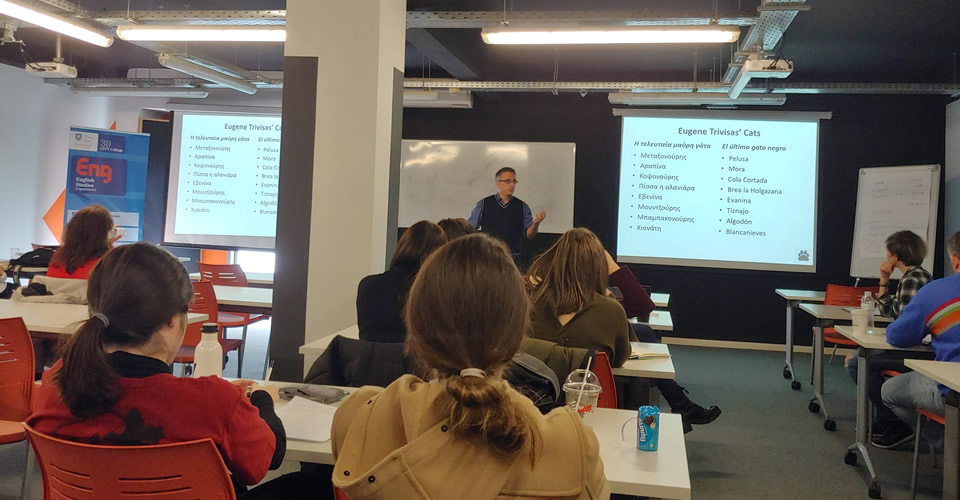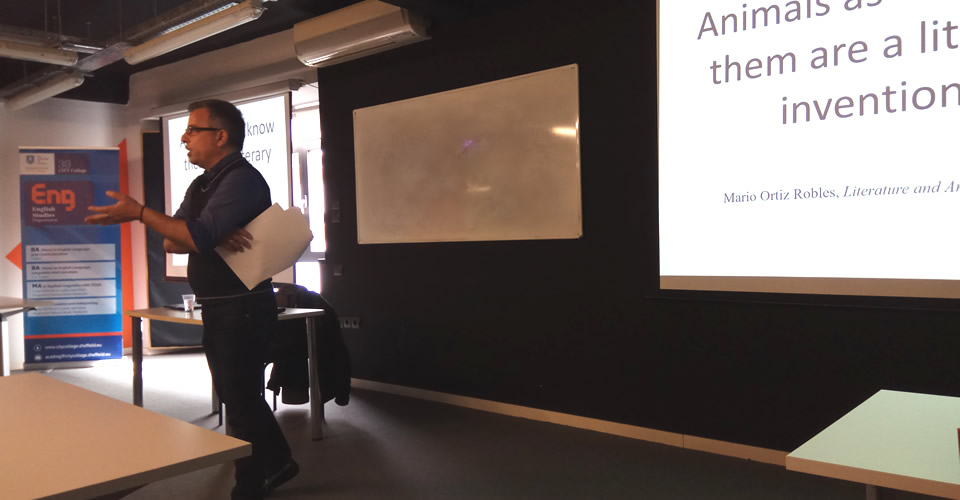The English Studies Department Comparatively Considers the Case of the Translatable Cat
The first Personal and Professional Development Seminar of the Spring semester that was organised on Tuesday, 3rd March by the English Studies Department, began on a whimsical note by considering the translation of certain animal figures and their names in literature. Drawing on the areas of comparative literature, children’s literature, and literary animal studies our guest speaker, Dr. Panagiotis Xouplidis, in his seminar titled: "The comparative cat and how to translate it - A case of Literary Animal Studies" focused specifically on the case of the cat and how to translate it.

Dr Xouplidis initially provided an overview of what constitutes comparative literature and how it is seen today. Drawing on concepts and dichotomies such as national/international, local/global, colonial/post-colonial/imperialistic, today comparative literature can be seen and understood as political ideologies but also literary systems that act as parts of universal systems thus indicating that these systems are not in isolation but part of a polysystem and to see them as such is integral when it comes to matters of translation.
The matter of similarities and differences in literary systems may appear easy to identify and examine when it comes to children’s literature which has a tendency to rely on stereotypes or archetypes and what some may view as simplistic representations and stories. Nevertheless, these stories enrich national, and international, identities and can have a great impact on how cultures perceive themselves and others. One common feature across children’s literature is that of the animal – or non-human animal – figure and it is this figure that has led some scholars to consult the area of Animal Studies for theoretical and scientific support in their research examinations.

Animal Studies is an area that requires an interdisciplinary approach and can extend from elements of biology to sociocultural and anthropological aspects of animals in and across cultures. What is certain is that in literature animals are inventions/constructs whose representation speaks miles of a country’s culture. When considering the figure of the cat, for example, Dr Xouplidis makes the case for a Greek Cat and a Spanish Cat. While in both cases we have a cat, they are not in fact cats – but literary inventions – and where they are created, how they are conceived and what they are meant to represent and reflect ought to be considered when the need for translation arises.
To indicate this significance, Dr Xouplidis draws on the example of Eugene Trivizas’ The Last Black Cat (2001) and its Spanish translation. Providing a list of cat character names, Dr Xouplidis invited the audience to contemplate the aspects that should be considered when the respective names are to be translated and how the anthropomorphic dimensions of these characters can even play a role in the name assigned.
Yet another well-known example that was introduced was that of Puss in Boots in comparison with the figure of Zorro. This was further extended to consider the meaning of Zorro in Spanish (which means fox) and how the translation and consideration of certain animal figures may be dealt with through other concepts, such as that of the trickster in this particular case, thus alluding to mythologies and fables.
What we need to remember is that animals are as old as literature. Characters such as Puss in Boots and the Cheshire Cat are literary animals created by words in different languages. Following Dr Xouplidis seminar, it becomes apparent that the examination of such characters either with an eye towards translation or with a focus on literary systems can certainly benefit from an intersection of comparative literature and animal studies when contemplating the cat’s literary representation and how translating cat names could play a fundamental role in a cat characters’ reception.








